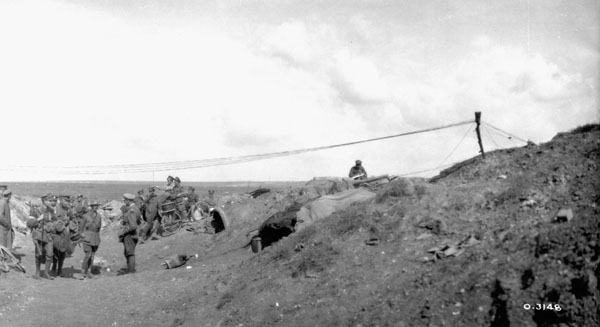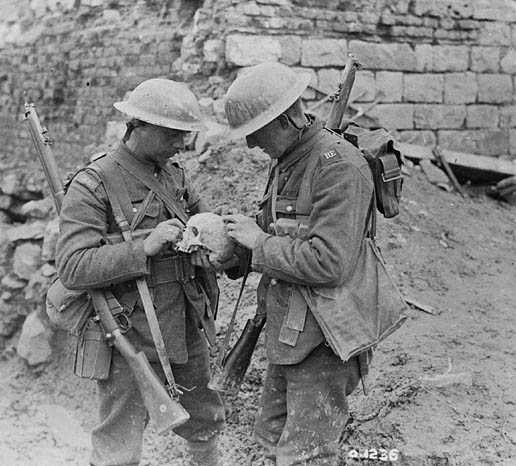 |
| German rifle being used as telephone wire pole. Advance East of Arras. August, 1918. Credit: Canada. Dept. of National Defence / Library and Archives Canada / PA-040216 |
The war's psychological effects on Burns are interesting to contemplate. Burns' role as officer commanding of the 11 Brigade signals section meant that he did not accompany the first infantry waves over the top. This did not prevent him from observing first-hand the horrors of war. Burns wrote in his memoirs:
"...I was passing along the same route with some men, when shelling began we decided to make our way along what passed for a communication trench near the Courcelette cemetery. In many places the trench was over knee-deep in liquid mud. At one point I stepped on something which yielded, and there rose up before me the rear end of a dead German. His clothes had been torn off, and his flesh, visible in places through the mud, was green. By that time we had been living for many days in the stink and visible presence of dead men, and so this very horrid sight excited no more than a moment's shock and disgust. But the memory has remained." (Burns, p.27)
 |
| Examining a Skull found near Vimy Ridge. W.I. Castle Library and Archives Canada / PA-001211 |
 |
Burns later commanded I Cdn Corps in WWII Italy DND photo – CFPU ZK704 Canadian Military Journal General H.D.G. Crerar (left) and Lt-Gen. E.L.M. Burns in Italy, 1944. |
Burns' considerable intellectual efforts to modernize the Canadian Army in the interwar years may have had something to do with these grisly experiences in the mud of France and Flanders. Mobile, mechanized warfare offered an answer to the bloody attritional stalemate of the Great War. Burns' major command in the Second World War, that of the I Canadian Corps, would also see its share of mud and blood. One can only speculate on the effects of Burns' Great War experiences on his later command. He certainly would have had a memory stocked with the brutal effects of combat to add to the strain of the responsibilities of leadership.
General Mud and General Winter seem to be far more effective than any mere mortal. Good thing this guy learned the lesson before WWII.
ReplyDelete